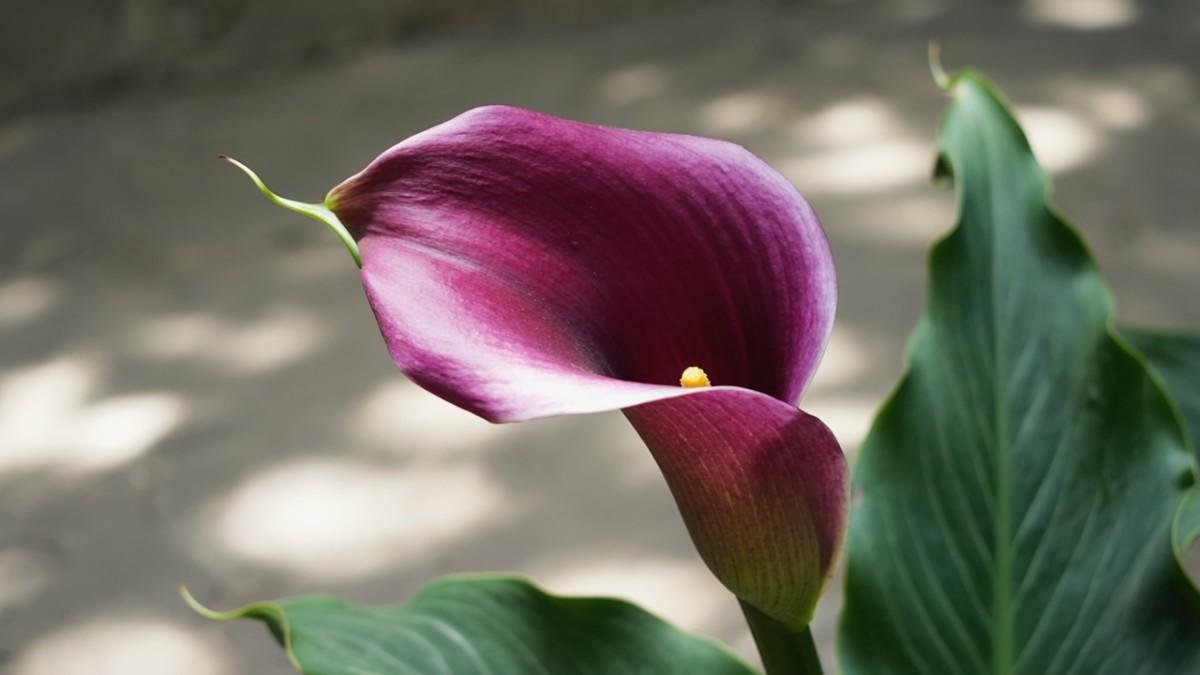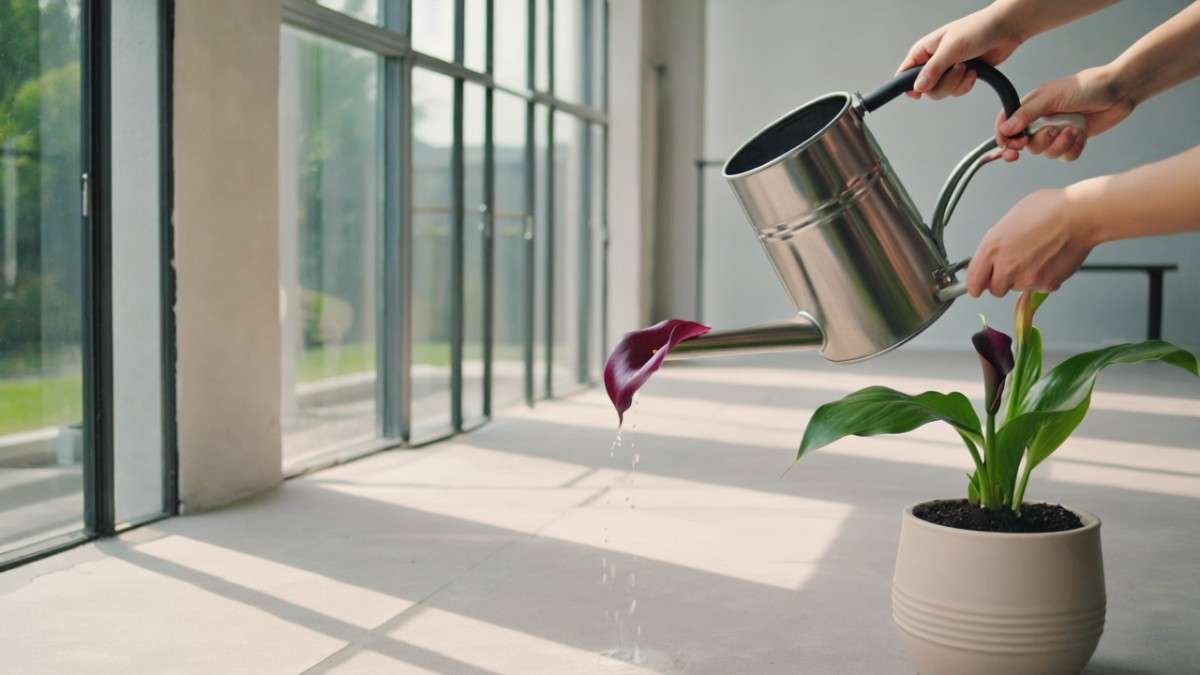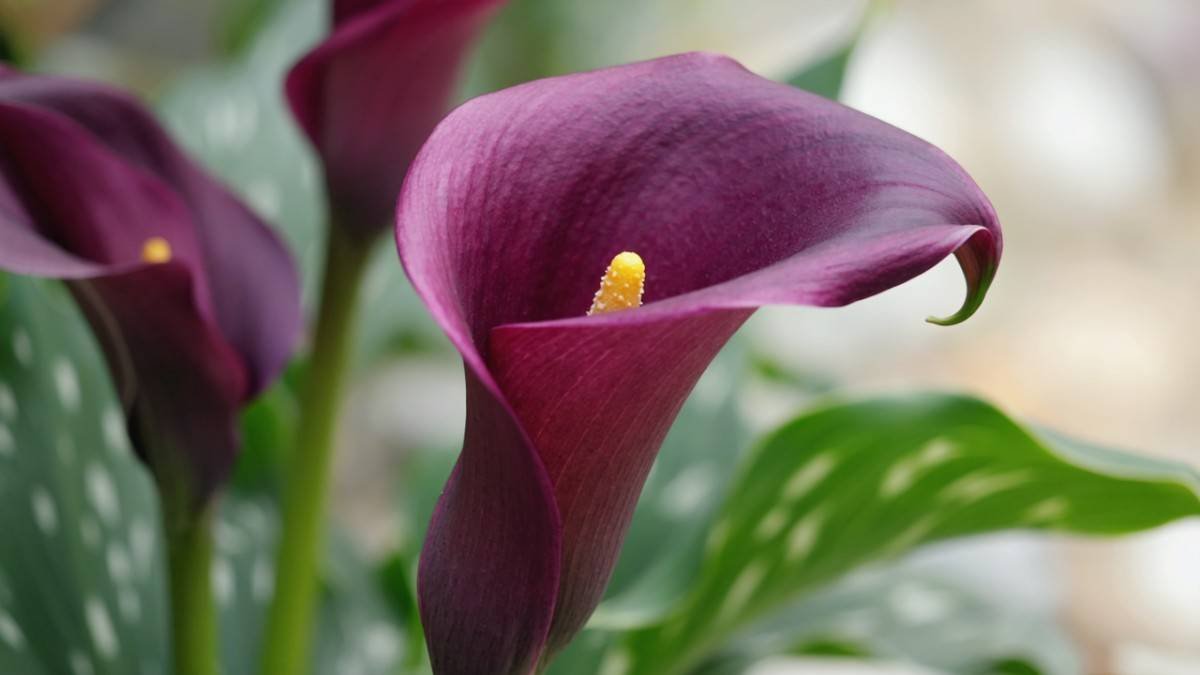A Love Letter to Purple Petals Let’s not beat around the bush—plants can be boring. But the purple calla lily plant? Oh no. She’s not just a plant. She’s an experience. Bold. Mysterious. A bit moody. The kind of bloom that waltzes into a garden party in a velvet dress while everyone else is still in denim. I remember the first time I saw one at a garden center. I froze. It was like the flower looked at me and said, “Yes, I am the moment.” And let’s be real, it was. That was the day I fell in love. No turning back.
What Is a Purple Calla Lily Plant Anyway?

Technically speaking, it’s not even a lily. Shocker, I know. Despite the name, the purple calla lily plant belongs to the Zantedeschia family. And while “Zantedeschia” sounds like the name of a perfume brand in Milan, it’s actually a genus of flowering plants native to southern Africa. The purple variety is a cultivar, bred specifically to produce that deep, rich plum color. It thrives in well-drained soil and needs just enough sun to glow, but not enough to crisp like a potato chip. Basically, it’s like us on vacation—just the right amount of sunshine and shade. (Purple Calla Lily Plant)
Why Purple? Color Psychology in Your Garden

Let’s talk color. Purple isn’t just pretty. It’s powerful. It’s royalty. It’s the color of creativity and mystery. When you plant a purple calla lily plant in your yard or keep one indoors, you’re not just adding color—you’re changing the vibe. Gardens full of soft pinks and whites? Lovely. But toss in some purple, and suddenly, it’s giving Renaissance poetry meets secret garden. The depth of that hue draws the eye. It lingers. It says something. So if you want your guests to whisper “wow” when they walk past your flower bed, purple’s your move.
So Easy, Even I Didn’t Kill It

Let’s be honest—we’ve all murdered a houseplant or two. RIP to the aloe I thought needed daily watering. But the purple calla lily plant? It’s surprisingly forgiving. As long as you don’t overwater it or toss it in full scorching sun, it holds up like a champ. Pot it, water when the soil’s dry, and give it some filtered light. That’s it. It’s like the low-maintenance best friend who still looks fabulous at brunch. Plus, it even tolerates beginners. Seriously, if you’ve got commitment issues or a brown thumb, this one’s a solid choice.
A Flower with Sass and Substance
This isn’t just about looks (though, yes, it’s a stunner). The purple calla lily plant has range. It works in bouquets, weddings, funeral arrangements, or just solo in a vase—where it silently judges your living room décor and improves it with its mere presence. It also has symbolic weight. In many cultures, purple lilies represent admiration, charm, transformation, and elegance. Basically, it’s the friend who quotes Oscar Wilde and also fixes your resume. A bloom with layers. And attitude.
The Journey from Bulb to Beauty

If you’re brave enough to start from scratch, planting calla lily bulbs can be a deeply satisfying journey. These little lumps of promise look like tiny potatoes, but oh, what they become. The purple calla lily plant grows from rhizomes, which you can plant in spring once the frost threat is gone. Bury them about 4 inches deep, spaced out, and wait. Slowly, they’ll unfurl into tall, sleek stems topped with those hypnotic purple spathes. Watching them bloom feels like magic. Like raising royalty from the dirt. (But without the drama of a tiara.)
The Right Soil Is Like Good Shoes—Essential
Soil is the foundation. The base layer. The metaphorical shoes of your plant’s outfit. And for your purple calla lily plant, it matters. These beauties love well-draining, slightly acidic soil. Think loamy, not clay. You want the water to flow—not puddle and drown the roots. If you’re working with a heavy garden bed, mix in some compost or peat moss to lighten things up. I once made the mistake of planting mine in a spot that turned into a swamp during rain. It didn’t end well. Lesson learned. Drainage is non-negotiable.
Sunlight, But Make It Fashion

Here’s the thing about sun: too little, and your plant pouts. Too much, and it fries. The sweet spot? Bright, indirect light. Outdoors, filtered sun under a tree canopy is ideal. Indoors, a sunny windowsill with a sheer curtain works like a charm. The purple calla lily plant doesn’t want to tan—it wants to glow. Trust me, you’ll know it’s happy when those purple blooms start popping like royal trumpets in your garden or home.
Water Like a Smart Human (Not a Helicopter Parent)

Watering can be the downfall of many plant parents. Overdo it, and you’re practically committing floral manslaughter. Underdo it, and you’re creating a plant desert. The purple calla lily plant prefers moist soil—but not soggy. Think “damp sponge,” not “marshland.” Water deeply, but let the top inch dry out before going back for round two. In containers, make sure your pots have drainage holes. No one likes wet feet, not even calla lilies. A little awareness goes a long way. Water smart, and you’ll get blooms that practically strut.
Purple Calla Lily Plant in Pots? Absolutely.
Yes, they thrive in the ground, but don’t underestimate a good container moment. If your garden is more “balcony chic” than “yard oasis,” fear not. The purple calla lily plant grows beautifully in pots. Use a medium-sized container, give it good potting mix, and make sure it has that all-important drainage hole. Bonus tip? Rotate it every few days so all sides get some light. And if you really want the drama, choose a white or black pot—it makes the purple practically sing.
Propagation: Making More of That Purple Magic
So you’ve got one purple calla lily plant and you’re in love. I get it. Now the only logical thing to do is… get more, right? Welcome to the joy of propagation. Thankfully, it’s not some weird plant science experiment—it’s pretty straightforward. Once your plant has finished blooming and the leaves start to yellow, it enters dormancy. That’s your moment. Gently dig it up and separate the rhizomes—those underground chubby little tubers. Each one is like a seed of royalty waiting to rise. Just replant them in the next season. Multiply the beauty. Share the wealth.
When Do They Bloom? Timing the Drama
Like all divas, the purple calla lily plant doesn’t perform on command. It has its season, and it sticks to it. Expect blooms in late spring to early summer, especially if planted in the right zone (USDA zones 8–10, or cooler zones with overwintering indoors). Each flower lasts about a month, and each plant can pop out several blooms if it’s happy. The leaves are lush too—arrow-shaped and sometimes dotted with silvery freckles. Even when it’s not blooming, it’s still serving looks. If only all our roommates could do the same.
Common Problems (And How to Win the Battle)
Now for the dark side. Because every fairytale has villains. Your purple calla lily plant can suffer if you don’t pay attention. The biggest threats?
- Root rot (usually from overwatering—stop drowning the poor thing!)
- Aphids (tiny sap-sucking vampires; try neem oil or insecticidal soap)
- Fungal spots (make sure there’s airflow and remove affected leaves)
- Yellow leaves (could mean too much sun, not enough nutrients, or overwatering)
Solution? Be observant. Check the leaves weekly. Catch issues early. Most problems come from love—but like, too much love. Plant parenting 101.
Purple Calla Lily Plant Indoors: Your Living Room’s New MVP
If you’re a city dweller or your idea of gardening is a windowsill with ambition, you’ll be happy to know the purple calla lily plant is a fantastic indoor guest. Just remember: it doesn’t like stuffy corners or soggy pots. Place it in a bright room, maybe near a north or east-facing window. Bonus points if the pot looks chic. Water it right, and it’ll reward you with that rich violet drama year after year. It’s basically the houseplant version of a moody artist with impeccable style.
Winter Care: Don’t Let It Die of Cold Feet
Calla lilies are tropical at heart. If you live somewhere that gets frost, your purple calla lily plant will need a little TLC to survive winter. Around late fall, after it yellows and wilts, dig it up gently. Trim off the dead stuff. Dry the rhizomes for a few days, then store them in a paper bag with peat moss or newspaper in a cool, dark place (like a garage or closet). Come spring? Replant. Like a phoenix from the ashes. Only prettier and less dramatic.
Creative Ways to Use Purple Calla Lilies

These flowers aren’t just for pots and borders—they’re style icons. Florists adore them for:
- Wedding bouquets – classic, bold, romantic
- Funeral arrangements – respectful, elegant, peaceful
- Home décor – pop a few in a minimalist vase and boom, instant luxury
- Photo shoots – because their curves and colors practically pose themselves
The purple calla lily plant is a mood. Use it where you want that little gasp of “wow” from your guests. It’s a design statement, not just a flower.
Symbolism: What These Beauties Mean
Flowers speak, even if they don’t have mouths. And the purple calla lily plant? Oh, it’s got something to say. It symbolizes admiration, beauty, transformation, and rebirth. In some traditions, purple also hints at mystery, spirituality, and deeper inner truth. That’s a lot for a plant, huh? But hey, we all contain multitudes. Giving someone a purple calla lily is like handing them a bouquet of meaning. You’re not just giving flowers. You’re giving vibe. And emotion. And drama. The best kind.
Who Should Grow Purple Calla Lilies? (Spoiler: Everyone)
Let’s break it down. The purple calla lily plant is for:
- The first-time plant parent who wants something elegant but not too needy
- The seasoned gardener who’s tired of boring color palettes
- The apartment dweller craving class in a corner
- The romantic who speaks in florals
- The person who likes compliments—because this plant gets them
There’s really no one it doesn’t suit. Unless you’re allergic to beauty. In that case… maybe stick to cacti.
Tips and Tricks: The Plant Whisperer Edition

Want your purple calla lily plant to thrive like a supermodel in sunlight? Here’s what you do:
- Feed it during bloom season – A balanced liquid fertilizer every 2–3 weeks
- Deadhead regularly – Remove spent blooms to encourage more
- Rotate the pot – Even light = balanced growth
- Don’t freak out when it dies back – It’s going dormant, not giving up on life
- Talk to it – No science here, but hey, can’t hurt
Consistency is everything. Like any good relationship.
Fun Fact Corner: Impress Your Guests
Drop these nuggets at your next dinner party:
- The “flower” is actually a spathe—a modified leaf. The real flower is the tiny spadix inside.
- In ancient Rome, calla lilies were considered symbols of lust. Scandalous.
- Despite their grace, all parts of the plant are toxic if ingested. So, keep it away from pets and toddlers who think everything’s a snack.
Suddenly, you’re the most interesting person in the room. You’re welcome.
The Final Bloom: Why This Plant Sticks With You

Here’s the thing about the purple calla lily plant—it leaves an impression. Long after the flowers fade and the pot goes dormant for the winter, you still think about it. Its elegance. Its quiet power. Its resilience. It’s the kind of plant that teaches you to slow down and notice. To admire complexity. To appreciate beauty that doesn’t shout but sings softly.
It’s not just a plant. It’s a companion. A tiny purple life lesson growing from dirt.
In Summary (But Not Really the End)
Let’s recap this blooming journey:
- Easy to grow, even for beginners
- Loves indirect sun and moist soil
- Propagates easily via rhizomes
- Blooms in spring to early summer
- Perfect for pots, décor, weddings, and vibes
- Symbolizes admiration, transformation, and elegance
- Brings mood, mystery, and majesty wherever it goes
The purple calla lily plant is more than a flower. It’s a feeling. A story. And now? It’s part of your story too.
Final Words:
So go on. Grab that pot. Dig that hole. Water with intention. And plant something beautiful. Because the world needs more purple. And so do you.
Purple Calla Lily Plant Advice You Actually Need
Let’s not sugarcoat it—plants can be tricky. But the purple calla lily plant? She’s a diva you can handle. With the right mix of love, light, and tough boundaries, she’ll reward you with elegance, grace, and those deep purple curves that make your neighbors gasp. So here’s a friendly, no-fluff guide full of advice—700 words of truth, trials, and tips to make your calla lily flourish.
Start Strong: It’s All About the Bulbs
Buy healthy rhizomes. That means fat, firm, and blemish-free. Think “baby potatoes” with ambition. If they’re mushy or moldy? Don’t even think about it. These bulbs are the literal root of success. Plant them in spring when frost has packed its bags and gone home. Trust me—planting too early is like sending a swimsuit to a snowstorm. Timing matters.
Give It Good Soil—Not Just Any Dirt
The purple calla lily plant doesn’t do basic. Give it well-draining, slightly acidic soil. Mix compost or peat moss into your garden bed or potting mix to help things breathe. If you use straight-up heavy garden soil, you’re just inviting drama. And root rot. Which leads us to…
Watering: The Art of Not Killing With Kindness
Calla lilies like moisture—but they’re not swamp creatures. Keep the soil damp, not soaked. Water when the top inch feels dry. Overwatering is the number one way people accidentally commit planticide. A good tip? Stick your finger in the soil. If it feels like a wrung-out sponge, you’re golden. If it’s mud? Step away from the watering can.
Let the Sunshine In… Gently
These beauties are not sunbathers. Think filtered light. Morning sun, afternoon shade. Indoors? A bright room with indirect light is perfect. If the leaves start to curl or turn brown at the tips, it’s screaming, “Too much sun, darling!” Rotate your pots every few days so each side gets a taste of light. Balance is key.
Feed Me, Seymour! (But Not Too Much)
During the growing and blooming season (spring through summer), give your plant a balanced liquid fertilizer every 2–3 weeks. Don’t overdo it. We’re feeding, not force-feeding. Too much fertilizer can lead to lush leaves but zero blooms. You want flowers, not just foliage.
Deadhead with Confidence
Spent flowers look sad. And they steal energy. So snip them off with clean shears to encourage more blooms. It’s like pruning bad energy from your life—satisfying and surprisingly effective. Always cut at the base of the stalk, not just the tip. Go big or go home.
Pest Patrol: Stay Vigilant
Aphids, spider mites, and fungus gnats might try to crash the party. Check under leaves weekly. If you see bugs, treat them early with neem oil or insecticidal soap. Don’t wait until it’s an infestation—because nobody wants bug drama. The sooner you spot a problem, the faster you can fix it.
It’s Not Dead, It’s Dormant
Late summer rolls around, and your plant starts to yellow and fade. Don’t panic. It’s just going dormant, not ghosting you. Reduce watering. Let the foliage die back naturally. If you’re in a cold zone, dig up the rhizomes, dry them, and store them somewhere cool and dry for winter. Then come spring, wake them up again. It’s the circle of (plant) life.
Toxic Alert—Keep Pets Away
Purple calla lily plants are toxic to cats, dogs, and curious toddlers. The calcium oxalate crystals inside can cause mouth irritation, vomiting, and worse. So if your furry friends chew on everything green, maybe admire your calla lilies from a safe shelf. Or better yet—just say no to indoor jungle cats.
Show Off (But Gently)
These flowers are made for drama. Use them in centerpieces, line a walkway, or place a pot by your front door. But don’t let them sit in hot sun or soggy pots for the sake of aesthetics. Beauty needs brains. If you love how it looks, take a picture. And then make sure it’s actually in a place where it can thrive.
Don’t Compare Yours to Instagram’s
Here’s the truth: what you see on Pinterest has probably been styled, filtered, and blessed by garden fairies. Your plant might bloom smaller. Or later. Or look a little wobbly at first. That’s okay. Real plants, like real people, grow at their own pace. Keep going.
Final Advice: Be Patient, Be Kind
The purple calla lily plant isn’t high maintenance—it just knows what it wants. Give it what it needs, and it’ll give you blooms that stop time. And if things go wrong? Try again. That’s gardening. That’s life. Messy. Beautiful. Full of second chances.
For more information about calla lily:
https://homegardeni.com/calla-lily-the-bold-beautiful-bloom-with-a-heart/

This was such a delightful read! The way you described the purple calla lily made me feel like I was meeting a garden diva. Loved the humor!